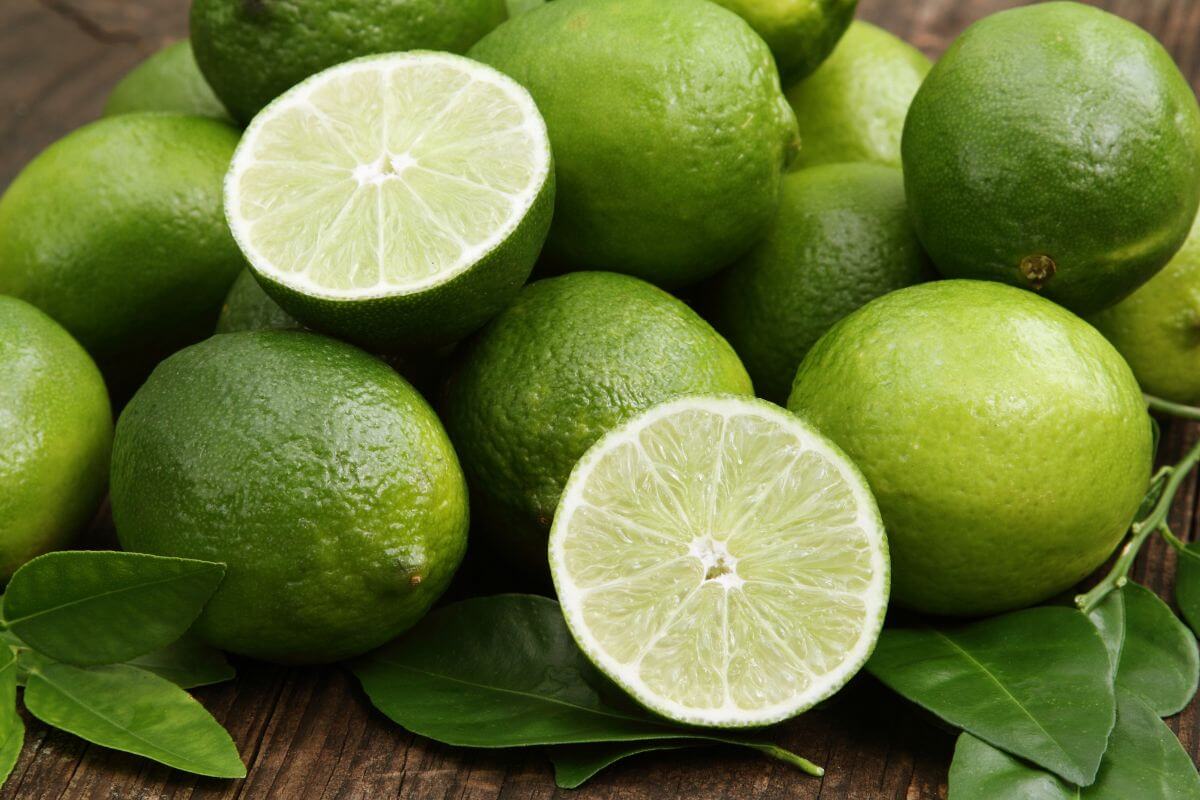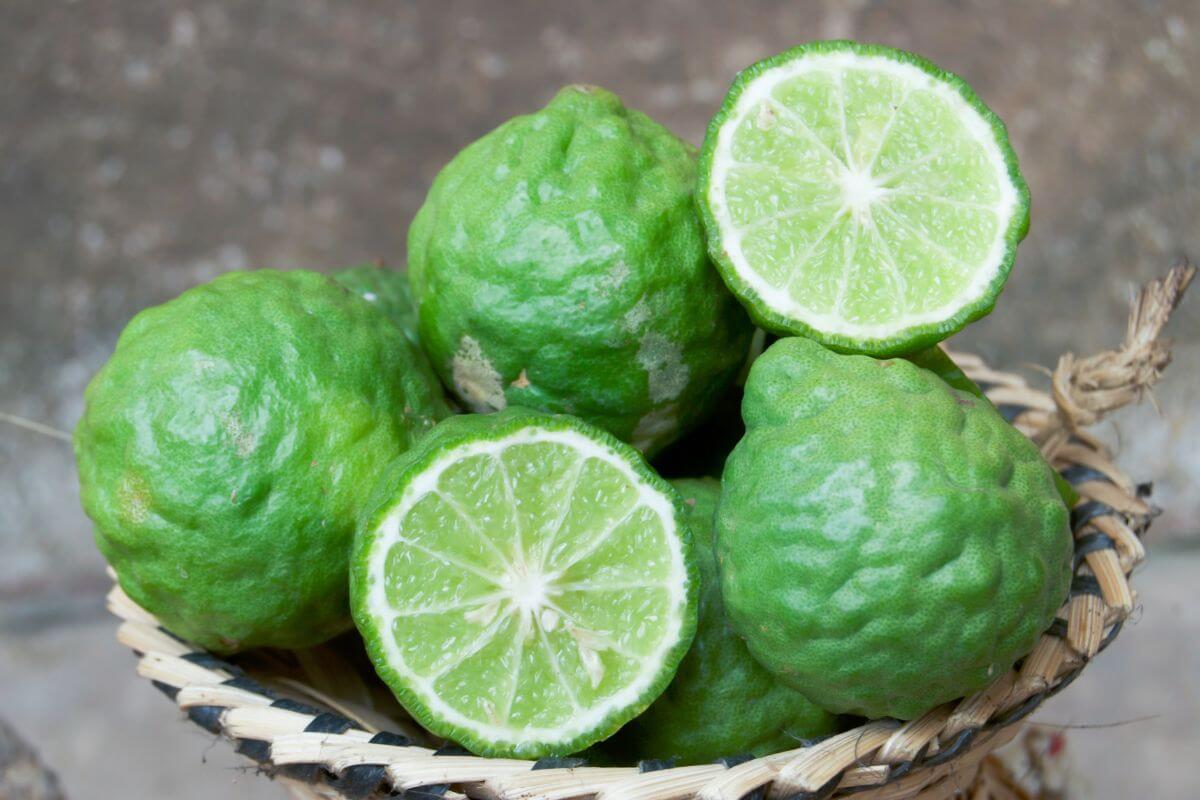Curious to know if that tangy green citrus in your kitchen is a fruit or a vegetable? You’re not alone. The lime, a zesty staple in many cuisines, often sparks this culinary confusion. Let’s peel back the layers on this juicy debate.
You’ll discover the scientific classification of limes and why they fall into the fruit category. I’ll explore their origins, various types, and how they differ from their citrus cousin, the lemon. Plus, you’ll learn about the surprising health benefits packed into these small green powerhouses.
Ready to squeeze out the truth about limes? Get ready for a zesty journey that’ll change how you see this versatile kitchen essential. You might even pick up some tasty tips for using limes in your cooking along the way!
- Related article: Vegetable and Fruit Comparison
5 Key Takeaways on Is Lime a Fruit or Vegetable
- Limes are fruits because they grow from lime tree flowers and have seeds. They are in the citrus family, like lemons, oranges, and grapefruits.
- There are many types of limes. You have Persian or Tahitian, Key or Mexican, Kaffir, Finger, Desert, Sweet, and Calamansi limes. Each type is different in size, acidity, and how you can use them in food and drinks.
- Limes are full of vitamin C and antioxidants. They help your immune system, reduce inflammation, aid in weight management, promote heart health, and may prevent kidney stones.
- You can use limes in many ways in cooking. They add tartness and improve flavor. They are key in Southeast Asian and Mexican cuisines. You can use them in marinades, sauces, desserts, and drinks.
- Limes and lemons are often compared, but they are different. Limes are more acidic and have a different taste and appearance. They also have different nutritional content and origins. Lemons are more common in Western cooking, while limes are used more in tropical and subtropical dishes.
Is Lime a Fruit or a Vegetable?

You might be surprised to learn that a lime is considered a fruit both scientifically and in cooking. Science classifies it as a fruit, and in cooking, it is used as a fruit for its acidic and flavorful juice.
The lime’s botanical name is Citrus aurantiifolia. Commonly, it’s known as the Key Lime Tree. There are other types of limes too:
- Citrus glauca (Desert lime)
- Citrus latifolia (Persian lime)
- Citrus hystrix (Makrut lime)
Limes thrive in Central America and Mexico. Some believe they first grew in Northern India, Malaysia, and Myanmar.
Why Is Lime a Fruit?
Limes are classified as fruits because they grow from flowers on lime tree branches and contain seeds. Fruits are plant parts with female reproductive organs.
Limes belong to the citrus fruit category. They are the fruit of various citrus tree species in the Rutaceae family. Limes, like lemons, oranges, and grapefruits, are true fruits.
Limes are similar to other citrus fruits. They are a good source of vitamin C, antioxidants, and other beneficial plant compounds.
You can use limes in a variety of dishes both sweet and savory. They work in cocktails, desserts, marinades, and sauces. This versatility is typical of fruits.
In cooking, limes are treated as culinary fruits, much like lemons. Limes add tartness, acidity, and flavor to many sweet and savory dishes, drinks, and desserts. Their high water and acid content also make them fruit-like.
What Are the Different Types of Limes?

Let’s have a look at the different kinds of limes you can add to your kitchen.
| Type of Lime | Characteristics | Uses |
|---|---|---|
| Persian/Tahitian Limes | Seedless and juicy with balanced acidity. Widely grown in Mexico, Brazil, and Spain. | The most common limes you’ll find in supermarkets. Used in a variety of dishes. |
| Key/Mexican Limes | Also called West Indian or bartender’s limes. Smaller with thinner skin. More acidic than Persian limes. | Used in key lime pie and for seasoning fish. |
| Kaffir Limes | Wrinkled, heavy appearance. Little juice, but very aromatic leaves and zest. | Popular in Southeast Asian cooking. |
| Finger Limes | Long, finger-like shape with tiny juice vesicles that burst with flavor. | Originated in Australia, now grown worldwide. Used for their unique texture. |
| Desert Limes | Small, round, and tart. | Ideal for jams, chutneys, and other preserves. |
| Sweet Limes | Pale yellow with a mild, honey-like sweetness. | Used in Indian, Middle Eastern, and Latin American dishes. Can be eaten raw or used in drinks, chutneys, and marinades. |
| Calamansi Limes | Hybrid of kumquats and mandarin oranges. Bright green exterior and orange interior. | Known as Philippine, calamondin, or musk limes. |
What Are the Differences Between Lemons and Limes?

Despite having similar uses, lemons and limes are not the same thing. Let’s find out how they differ.
| Feature | Limes | Lemons |
|---|---|---|
| Appearance | Small and round with bright green rinds. Lime trees are smaller with slender branches. | Larger and oval-shaped with yellow rinds when ripe. Lemon trees have larger, oblong leaves and wider branches. |
| Taste | More bitter and acidic, offering an acidic, tart, slightly sweet flavor. | Sour and pucker-inducing, known for their sour, refreshing taste. |
| Acidity (pH) | Generally more acidic, with a pH between 2.00-2.35. | Lemon juice has a pH of 2.00-2.60, making it slightly less acidic than lime juice. |
| Nutritional Content | Contains more vitamin A. | Contains more vitamin C and folate. |
| Origin | Originated in Asia and thrive in tropical and subtropical climates. Mainly grown in Brazil, Mexico, and South America. | Can grow in more moderate regions worldwide and are produced globally. |
| Culinary Uses | Common in Southeast Asian, Mexican, and Thai cuisines. Adds acidity and flavor to dishes, drinks, and cleaning products. | More prevalent in Western cooking and baking. Adds acidity and flavor to dishes, drinks, and cleaning products. |
- Read more: Are Lemons Classified as Fruit or Vegetable?
What Are the Health Benefits of Lime?
How does consuming lime help your health? You’d be surprised to learn some of its benefits.
1. Lime Supports Immunity
Limes pack a punch when it comes to boosting your immune system. These zesty fruits are loaded with vitamin C. This powerful nutrient helps your body fight off pesky germs and infections.
But that’s not all! Limes are also full of antioxidants. These little warriors go to battle against harmful free radicals in your body. Free radicals can weaken your immune system if left unchecked. By neutralizing them, limes help keep your defenses strong.
I’ve found that adding a squeeze of lime to my water or tea each day gives me an extra boost. It’s a simple way to support your immune system. Plus, it adds a refreshing zing to your drink.
2. Lime May Reduce Inflammation
These green fruits are full of special compounds called flavonoids. Two key players are hesperidin and diosmin. They work hard to calm down inflammation in your system.
Limes are also loaded with vitamin C. This powerful nutrient helps your body in two ways:
- It reduces oxidative stress
- It battles those pesky free radicals
Limes have another trick up their sleeve. They can stop certain enzymes that cause inflammation. One of these troublemakers is called cyclooxygenase. Limes put the brakes on its activity.
Want to boost your health? Try adding more limes to your diet. Squeeze them over salads. You’ll get a tasty kick and some great health benefits too!
3. Lime Aids Weight Management
Limes can make you feel full thanks to their fiber content. This means you might eat less overall. The citric acid in limes may also give your metabolism a boost. It could help your body burn fat more efficiently.
Want a simple way to cut calories? Try swapping your usual drinks for lime water. It’s refreshing and low in calories. Plus, it’s way better for you than sugary sodas or juices.
Have you tried infusing your water with different lime varieties? It’s a fun way to mix things up and enjoy the benefits of these tangy fruits.
4. Lime Promotes Heart Health

Limes are not just tasty — these little green fruits can help keep your ticker in top shape. The potassium in limes works to balance out sodium in your body. This helps keep your blood pressure in check.
But that’s not all. Limes contain special plant compounds called sterols. These might help lower your bad cholesterol levels. That’s good news for your heart.
Let’s talk about antioxidants. Limes are full of them. These powerful substances protect your heart from damage. They fight off harmful molecules that can hurt your cardiovascular system.
5. Lime May Prevent Kidney Stones
The citric acid in limes can boost your urinary citrate levels. This helps grab and remove extra calcium from your system. But that’s not all limes can do for you.
These little green fruits are also rich in magnesium. This mineral plays a key role in how your body handles calcium. It helps control how much calcium you absorb and use.
Want to keep those pesky kidney stones at bay? Try sipping on lime water throughout the day. It can help thin out your urine and wash away stuff that might form stones. Plus, it’s a refreshing way to stay hydrated.
Here’s a quick rundown of lime benefits for your kidneys:
- Boosts urinary citrate
- Removes excess calcium
- Regulates calcium absorption
- Dilutes urine
- Flushes out stone-forming substances
6. Supports Skin Health

Want to know a secret for smooth skin? It’s hiding in your fruit bowl! Limes pack a punch when it comes to skin health. These little green powerhouses are loaded with vitamin C. Your body needs this vitamin to make collagen. Collagen keeps your skin firm and young-looking.
Limes are also full of antioxidants. These tiny warriors fight off damage from the sun and other nasty things in the environment. They’re like a shield for your skin.
Here’s a fun tip: try using lime juice on your face. It can help remove dead skin cells and make your skin brighter. Just be careful not to overdo it!
7. Lime May Protect Against Cancer
Limes contain compounds that may help lower your risk of certain types of cancer. The secret lies in their antioxidants, especially flavonoids. These little superwarriors work hard to block cancer from developing and spreading.
Research shows citrus fruits like limes might help fight off several types of cancer:
- Bone marrow cancer
- Breast cancer
- Colon cancer
- Esophageal cancer
- Lymphoma
- Pancreatic cancer
- Throat cancers
Have you tried incorporating more citrus into your diet? It’s a small change that could make a big difference in the long run.
Remember, while limes are great, they’re just one piece of the puzzle. A balanced diet with lots of fruits and veggies is key to overall health.
Different Ways to Add Lime to Your Diet

When it comes to lime, there are a ton of drinks and dishes you can add them to. Check them out:
Drinks:
- Add lime juice to water, seltzer, or tea for a refreshing drink.
- Use lime slices in cocktails like margaritas, mojitos, or gin and tonics.
- Blend lime juice into smoothies with fruits, veggies, and yogurt.
Salads and Dressings:
- Drizzle lime juice over green salads or grain bowls.
- Make a zesty vinaigrette with olive oil, lime juice, honey, and seasonings.
- Add lime zest to creamy dressings like ranch or Caesar.
Cooking:
- Use lime juice to marinate chicken, fish, or tofu before cooking.
- Stir lime juice into salsas, chutneys, or pico de gallo.
- Add a splash of lime juice to curries, stir-fries, or rice dishes.
Desserts:
- Bake lime into pies, tarts, or bars for a tangy twist on desserts.
- Make lime sorbet or granita for a refreshing treat.
- Fold lime curd into whipped cream or yogurt for a quick parfait.
Garnishes and Flavors:
- Serve sliced limes with seafood, tacos, or tropical drinks.
- Zest limes over dishes like avocado toast or grilled vegetables.
- Sprinkle lime juice over roasted potatoes or sweet potato fries.
Limes add a bright, tart flavor to both sweet and savory dishes. Start with just a squeeze or a sprinkle, then adjust to your taste. Enjoy the refreshing taste and health benefits of limes in your daily diet.
Is Lime a Fruit or a Vegetable? Final Thoughts
Limes are tasty little fruits that pack a lot of zing. You might think they’re just for cocktails, but these green gems do so much more. I love using them in my cooking and drinks. They’re not just delicious – they’re good for you too!
Did you know limes are super low in calories? But don’t let that fool you. These tiny powerhouses are full of good stuff your body needs. I always keep a few in my kitchen because they’re so handy.
Want to jazz up your water? Squeeze in some lime. Cooking a bland dish? Lime to the rescue! They’re like magic wands for your taste buds. And the best part? While you’re enjoying that zesty flavor, you’re also doing your body a favor.
So next time you’re at the store, grab a bag of limes. Your meals, drinks, and health will thank you. Trust me, once you start using limes regularly, you’ll wonder how you ever lived without them!
Check out these other articles to learn about other plants and foods to see if they’re a fruit or vegetable:

